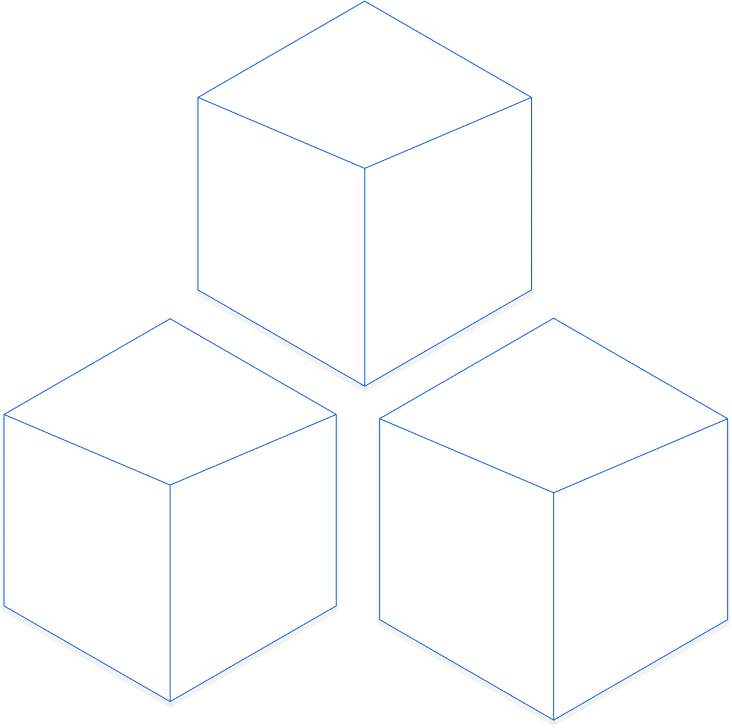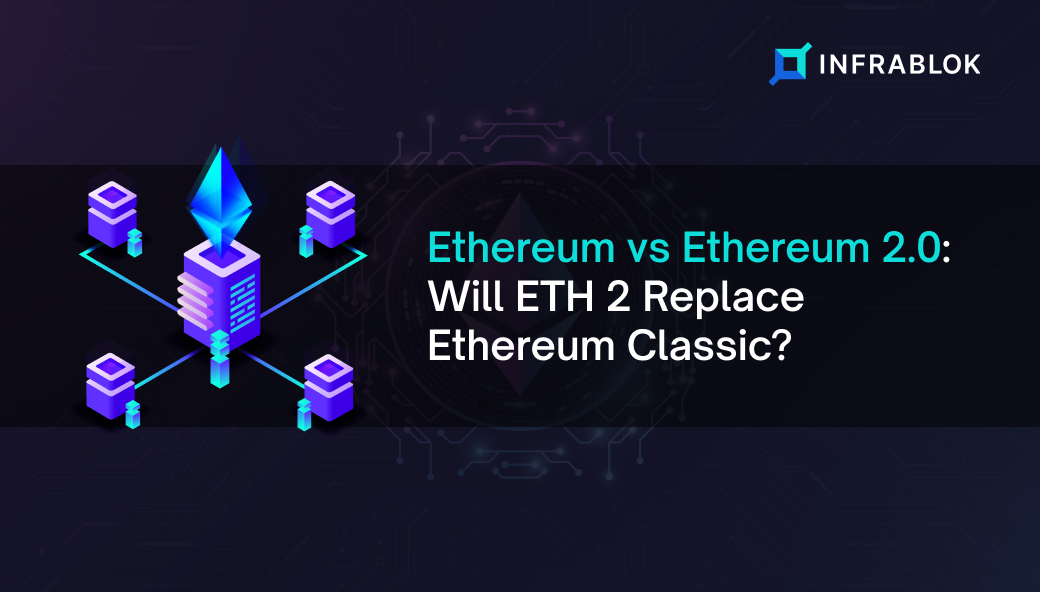Cryptocurrencies’ invention provided a new way to make investments and payments. With cryptocurrencies, Blockchain technology came into reality, revolutionizing the global markets. Blockchain, with cryptocurrencies (Bitcoin and Ethereum), is empowering various industries like healthcare, agriculture, banking, and more. It offers secure transactions at an affordable rate.
Moreover, Bitcoin is the very first cryptocurrency in the crypto space. Ethereum is the 2nd largest cryptocurrency and is home to several NFTs, DeFi, and dApps projects. In 2015 Ethereum’s first version came into existence.
But as we all know, timely updates enhance the working of technology and make it more user-friendly, and to meet the current market standard, Ethereum decided to roll out Ethereum 2.0 in 2022. Ethereum 2.0, or you can say “Serenity,” “Eth 2.0,” or the “New Ethereum,” aim is to give users sustainability and faster transaction speed.
Well, now you might be thinking about Ethereum vs Ethereum 2.0 which to buy? To help you make a suitable decision here, we have compared several factors that will help you get a clear understanding of Ethereum and Ethereum 2.0.
So, let’s get started!
Ethereum Overview

Vitalik Buterin, a Canadian-Russian programmer, launched Ethereum’s first version in 2015. It is an open-source, free, decentralized Blockchain platform that works on smart contract functionality and specifies a peer-to-peer network among its users.
With the popularity of smart contracts by Ethereum, worldwide programmers are able to use Blockchain to form dApps. Ultimately resulting in giving way to some of the significant crypto innovations, such as NFTs & Blockchain-based games.
Key Features
- Data Coordination
- Permissioned networks
- Private transactions
- Tokenization
Ethereum 2.0 Overview

Ethereum 2.0 is not completely a new Blockchain but an upgraded version of Ethereum. The governance mechanism of the network is modified from proof-of-work (PoW) to proof-of-stake (PoS). Whereas the new Ethereum update will help catch up with some of the newer Blockchains, including Polkadot, Cardano, Solana, etc., already using the PoS model.
Moreover, the PoS model is not sudden or unexpected. This update has been a part of Ethereum’s roadmap for a long time to attain more security, sustainability, and scalability.
Key Features
- Sharding
- Faster Transaction Speed
- Secure
If you want to know more about ETH 2.0, connect with the expert working in the reliable Ethereum app development company. By doing so, you will be able to get a clear understanding of how Ethereum can help you grow your business.
Difference Between Ethereum And Ethereum 2.0
The below-stated crucial features will help you know the difference between ETH and ETH 2 and analyze which one is better (Ethereum vs Ethereum 2.0).
Consensus Mechanism Modifications
Ethereum works on the proof-of-work (PoW) mechanism, whereas Ethereum 2.0 works on the proof-of-stake (PoS) mechanism. Moreover, the PoS mechanism helped Ethereum 2.0 become more decentralized in comparison with older Ethereum.
Since using the latest version of Ethereum, users don’t have to buy expensive rigs, and anyone with a specific amount of ETH can partake in mining new tokens. Resulting in more user participation leads to more decentralization.
Sharding
Another important update that makes Ethereum 2.0 different from the classic Ethereum is sharding. Sharding is a phenomenon in which data is distributed in various machines to enhance processing speed. Likewise, in Ethereum, it has been accomplished by orienting 64 shards.
Each shard is a new chain connected to the older Ethereum chain to link with the previously recorded data. Moreover, all work the same as the old one, but the difference is that Ethereum 2.0 workload has been distributed onto multiple databases.
Sharding directly manages Ethereum’s scalability issues. The classic Ethereum can only handle 15 transactions, whereas Ethereum 2.0 is much more efficient and can complete 100,000 transactions per second.
To make this point clear, consider the older Ethereum Blockchain as a one-lane highway with a lot of traffic. However, following the recent upgrade (Ethereum 2.0), 63 new lanes have been added. By doing this, the flow of traffic has been smoother, while its speed has increased.
Beacon Chain
We already discussed that the new Ethereum version that is Serenity, or Eth 2.0, is divided into 64 distinct chains and how validators are fixed to add a new data block to them. In addition, one Blockchain connects all 64 sharded chains to control the same, enabling transactions throughout the network. This central element is a major part of the entire ecosystem and is known as Beacon Chain.
Beacon Chain’s main functionality is that it randomly nominates the next validator and monitors its activity. Moreover, it’s also liable for slashing the staked amount if an exploitative trial is witnessed. The randomness in validator selection is crucial to guarantee that the system is not biased toward a specific participant.
Cryptocurrency
Both networks, Ethereum Classic and Ethereum 2.0 have a native cryptocurrency with accounts & balances that can be transferred. On Ethereum Classic, it is known by the name of ether or ETC, and in Ethereum 2.0, it is known as ether or ETH.
In both networks, the currency can be split up to 10^18, making the smallest unit, the “Wei,” 0.000000000000000001 of 1 ETH or ETC.
Ethereum vs Ethereum 2.0: Comparison Table

Ethereum 2.0 vs Ethereum: Which One Is Better?
The factors stated here will clear all your doubts related to Ethereum Vs Ethereum 2.0: Which One Is Better? Ultimately aiding you in picking the best one for your business activities.
1. High Performance
Ethereum 2.0 utilizes PoS as a consensus mechanism and has a flexible monetary policy with no supply cap, and the database is fragmented, so more shards can process more transactions collectively. As a comparison, ETC currently has a throughput of ~680,000 transactions a day. This is perfectly comparable to high-value systems such as Fedwire (US) and Target2 (EU), which settle ~$11 trillion a day.
However, Ethereum 2.0 will handle many times the number of transactions. This means ETH 2.0 will be perfectly comparable, in small transaction performance, to PayPal, Visa, or even the proposed Libra currency by Facebook.
2. High-Level Security
The main goal of the new Ethereum community is to ensure high-level platform security for developers and investors. If I talk about older days, then each day, several hacking incidents on different Blockchains emerge, resulting in people losing their money. But moving toward a PoS system will surely minimize the threat of cyberattacks.
Moreover, Ethereum 2.0 can also deal with a threat that comes with a 51% attack risk. Being a decentralized platform, Ethereum’s developers must ensure that no single party tends to take over the bulk of the network.
3. Sustainability
Eco-friendliness is the most important thing a new project can do to gain a foothold in the Blockchain world. Ethereum’s Blockchain was dependent on mining under the old PoW consensus model.
To mine bitcoins, miners needed highly complex computing devices that consumed large amounts of electricity. But, the newer PoS model makes Ethereum 2.0 more eco-friendly and sustainable by eliminating the entire mining network.
4. More Scalability
Ethereum 2.0 has the capability of hosting numerous DApps and DeFi services. According to research, it has been found that Ethereum is home to nearly 80% and 90% of the total DeFi apps and NFTs, respectively. This activity generates a great deal of traffic and thousands of transactions every single day.
However, the classic Ethereum Blockchain can only manage 15 transactions each second. This resulted in users paying high transaction fees and dealing with delayed transfers.
Wrapping Up
After considering all the facts and figures related to Ethereum and Ethereum 2.0, we can clearly say that in the war of Ethereum vs Ethereum 2.0: Will ETH 2 Replace Ethereum Classic?, ETH 2 is the winner.
New Ethereum updates have made the crypto market more strong. The modification in the consensus mechanism proposes transparency, scalability, and enhanced security on the network. It will be a remunerative deal for enterprises and individuals.
Moreover, if you are finding a reliable partner to work on Ethereum-based projects or need any suggestions related to Blockchain-related projects, connect with the best Blockchain company (Infrablok).
Frequently Asked Questions (FAQs)
Ques 1. What are the 3 Phases of Ethereum 2.0?
Ans 1. Ethereum 2.0 is planned to be launched in 3 phases:
0 Phase: Beacon Chain
1 Phase: The Merge
2 Phase: Sharding
Ques 2. What is Sharding?
Ans 2. Sharding is the procedure in which one Blockchain diverges into different Blockchains. Therefore, one network works as a particular validator. Instead of executing all transactions via a single Blockchain, it can be done across various side chains. It makes the process more energy-efficient.





